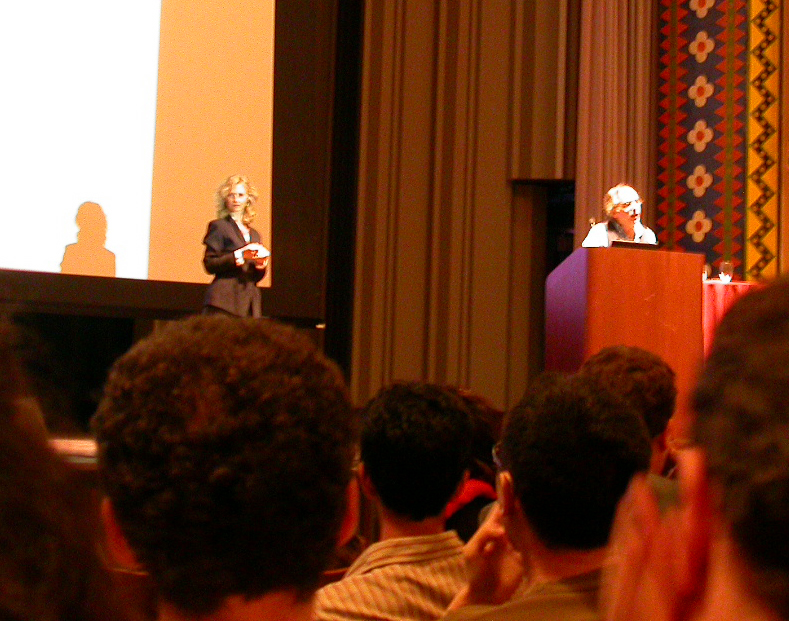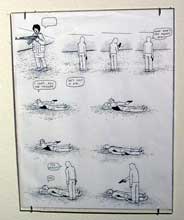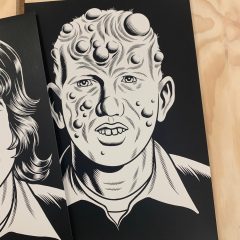
Art Spiegelman at Penn
I went to hear Art Spiegelman last week at the Penn’s Irvine Auditorium. The creator of the Pulitzer Prize winning graphic novel “Maus,” founder of “Raw” magazine and retired New Yorker cover artist was giving his “Comix 101” speech — a power point-enhanced history of comics and graphic novels as well as a history of his own involvement in the genre. The evening was part of the Penn Humanities Forum series “Word and Image.” (The series, which is open to the public, charges for the lectures. Here’s the full calendar. The prices are $8 or $5 for students)
(image is Spiegelman at podium and Penn’s Wendy Steiner on stage left)

Spiegelman,* (see note) who calls his comic art “picture writing” was the perfect lead-off speaker for this year’s series on words and images. Not only was he broad and amusing in his approach to the topic. But his speech was a comics-like swoop of words and images whipping around from autobiographical material to historical material (including the Katzenjammer kids, Little Nemo up to and including Chris Ware and our town’s own Charles Burns) and back to his awakening as a cartoonist with political content in the post-911 world. The speech packed a punch. It made the case that comix can be amazing art and captivating story-telling.
(image is the last slide Spiegelman showed. It illustrates an example of his new politically-inflected work)
Hot comix

Comix are hotter than ever with all the manga-love out there said the comix artist, who should know. Not only are his books prize-winning and used as texts in schools around the country but the artist said that revenues from their sales was allowing his daughter to attend Yale!
Spiegelman was upbeat about the future of the artform which he believes lies not in the Sunday funnies which he calls “genre” or “niche” comix but with the graphic novel and practitioners like Burns and Ware and, in the Japanese manga.
(image is a page from Burns’ new graphic novel “Black Hole.” A selection of the original drawings from the book is on view at Slought’s Comicology exhibit)
Where’s Satrapi in all this?

Spiegelman didn’t mention Marjane Satrapi’s graphic memoirs Persepolis and Persepolis 2 which I thought was interesting. Perhaps the autobiographical novels are close to his own “Maus” and so he didn’t mention them. (Can you call them novels? They were in the memoirs section of the bookstore and not with the other graphic novels when I bought my copies. Is Maus a graphic novel or a memoir? Does it matter — they’re both magical and surreal and beautiful examples of the merger of image and word.)

(Satrapi’s Persepolis books chronicle her childhood growing up in Iran before and after the 1979 Islamic revolution. She deals with the torture of political prisoners, her need to take up the veil, her parents’ political protesting and her finding refuge in Europe. There’s the Iran-Iraq war, a marriage that doesn’t work, her return to Iran and her eventual decision to leave again for Europe.)
It’s all presented in raw, high-contrast black and white panels that are elegantly surreal and surprisingly childlike for all their heavy material.)
(image is a page from Persepolis. It shows the artist and her parents on vacation in Italy and Spain in 1980)
Comicology
I was surprised also that the Comicology exhibit at Slought Foundation, guest-curated by Judith Stein and her nephew Gabriel Greenberg had no Satrapi presence. The exhibit’s subtitle: the New Magical Real” is broad enough surely to have included some of her loopy and patterned drawings.
Maybe it’s a taste thing. My first introduction to Persepolis was in an April 2005 review of the books by Patricia Storace in the New York Review of Books. Storace liked the memoir but dissed the drawings as full of awkward gestures and truncated bodies (something Satrapi herself explains as being due to her lack of experience drawing bodies — except when they’re covered by chadors.)
I think the works’ design sensibility and its stretching of time backwards and forwards in day-dream fashion is definitely child-like and also Persian miniature-like. And the stylized graphic approach goes very well with the story that is moody and dark but never loses its child-like sense of wonder and fury at injustice.
Nilsen and Gustun

Speaking of designs and styles of drawing, Comicology shows a wide range of drawing and story-telling approaches, from the awesome nightmare on the page work of Burns to the white-out heavy and collage-made works by Anders Nilsen.
(image above is a panel by Nilsen. The story is set in an arctic wasteland and I know it’s a generational thing but I kind of saw little humor in what seemed at root a nihilistic story with suicidal tendencies)

I loved much of what I saw and thought the line quality was amazing in most of it. I particularly loved the Philip Guston appropriated world invented by Marc Bell (he calls it Gustun land) with characters with klan hoods and characters that are heads with large eyeballs, and it’s all set in a scale-warped Where’s Waldo landscape. The works are tours de force and uniquely beautiful in spite of the great quoting from Guston and R. Crumb.
(image above is a panel from Bell‘s over-wrought Gustun-land)

I’ll leave it here except to say that Curator Stein wrote us and said her nephew Gabe had opened her eyes to what was new material for her. Don’t you love that? We will have an additional post or two about Comicology coming up soon. Stay tuned.
(image is graphic novels on a shelf in a small reading nook in the Comicology show at Slought)
________________________________
*[Note: If you’ve read Maus you know that the autobiographical work chronicles the artist’s interviews with his grumpy, neurotic, Auschwitz-survivor father, Vladik. Throughout Maus 1 and 2, Spiegelman depicts himself with a lit cigarette. I always thought that was a device to separate himself from his father (they are frequently together in the panels and of course, because they’re mice, they look amazingly alike).
But no, Spiegelman, indeed, is a chain smoker which he proved when he lit up in Irvine after about the 5th slide. The gasp heard round the room was audible. He mostly just waved the cig around after taking the initial puffs. There was too much to say and the voluble guy had little time to puff. I sat in the front so I got the smell-a-vision enhanced talk. I’m sure in the back it was a negligible presence. The cigarette turned the talk into a kind of stand up routine. At the end, when Penn’s Wendy Steiner came on stage to invite people to ask questions she was waving her hand in front of her face to keep the smoke away. Spiegelman mumbled something to acknowledge his transgression but kept lighting up all through the questions — as Steiner backed away from the podium and out of the downwind.]









